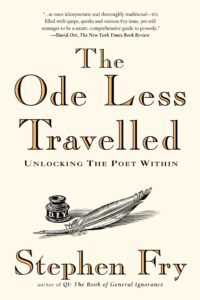Stephen Fry on Rhyme, Part 1
 As I mentioned previously, I’m working through Stephen Fry’s The Ode Less Travelled very slowly to absorb as much wisdom as I can about writing poetry. This week’s post covers Chapter 2, Section 1, on rhyme.
As I mentioned previously, I’m working through Stephen Fry’s The Ode Less Travelled very slowly to absorb as much wisdom as I can about writing poetry. This week’s post covers Chapter 2, Section 1, on rhyme.
Rhyme is something that I’ve always felt more comfortable with, especially compared to meter. And as Stephen Fry explains, that’s true for most people, because we start learning rhyme in nursery rhymes, which include both end rhymes, where the ends of the line rhyme, and internal rhymes, where a word in the middle of the line rhymes with other words elsewhere in the poem. But a lot of those nursery rhymes are the basic sort of rhymes that I find I often default to when writing rhyming poetry.
What the chapter does introduce, though, are the terms “assonance” and “consonance,” which are partial rhymes or slant rhymes. Assonance is when the vowels match but the consonants do not (bug/put), while consonance is when the consonants match but the vowels do not (road/rod). He explains that assonance is more common in internal rhymes than in end rhymes, and that even when a poem makes use of assonance, it generally should end with a full rhyme rather than a partial or slant rhyme.
This section of the first chapter didn’t really have an exercise to speak of, since most of it was reading various rhymed poetry and seeing how the different types of rhyming could be used to good and ill effect.

Comments